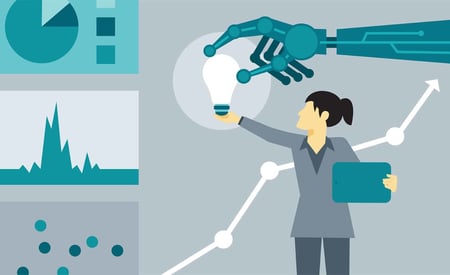
LinkedIn is like a Swiss Army knife, empowering people and brands to accelerate their career and business growth! It’s a content marketing platform. It’s a job board. Of course, at its core, LinkedIn remains first and foremost a social networking site with paid media networking too.
And you know what all these features mean, right?
Data. Tons of data (metaphorically speaking).
For B2B marketers, LinkedIn’s data may be one of the most overlooked features. Every feature captures data – how many article reads, post likes, shares, clicks, and more! – that a marketer can take, analyze, gain insight from, and use.
Collecting data on LinkedIn, however, isn’t quite as simple as pulling a report from Google Analytics or Facebook Insights. People data doesn’t always translate into numbers. Interests, behavior, and trends demand a human eye. Here then is the key to LinkedIn.
LinkedIn contains a wealth of data, but in two forms: brand intelligence and human intelligence. Let’s take a closer look at both to understand each better and how you can use them.
Brand Intelligence
Marketers will recognize this data. Captured through LinkedIn’s platform and available through the platform’s dashboard and reporting tools, it contains a lot of familiar data (think traffic), as well as advanced marketing solutions. For example:
Company Website Visitors. The LinkedIn Ads “Website Demographics” tool works a lot like Google Analytics. It gives you data on all website visitors, not just the ones coming from LinkedIn Ads. Websites with enough traffic can even compare audience segments on their website, such as companies and positions that visit different product pages.
Armed with this data, content can be written to better target audiences while sales teams can gain an understanding of expectations of prospective clients to better prepare for meetings and presentations.
Company Page Analytics. LinkedIn page administrators can measure activity on the brand page through this tool. Per LinkedIn, you can “Evaluate the effectiveness of your updates, including posted videos” and “understand more about demographics and sources of your followers and visitors.”
Like any analytics tool, it enables you to monitor performance via a variety of metrics and time periods, so you can spot trends and deliver more meaningful content.
LinkedIn’s Success Hub. Recently, LinkedIn introduced the new LinkedIn Insights and Research page. It’s part of LinkedIn’s Success Hub, a centralized source of tools to understand people, industries, and advertising opportunities better.
It’s a data-rich resource. For example, you can select a specific audience such as “IT Decision Makers,” “C-level,” and more to see the top locations of the audience (ie., US, UK, India), their top skills, and hottest content topics. As you filter, you gain access to the blog posts engaged by the audience.
Filtering is also available under Industry Insights, so you can better see what’s trending. Advertising Insights shares LinkedIn’s observations about what’s working on the platform.
Human Intelligence
While LinkedIn captures a lot of useful data, there’s a lot of “human data” available too. Yes, this includes contact information and the relationships your team has, but it really goes much further. When we help brands build integrated and collaborative LinkedIn marketing programs, we look at:
- Competitors. Brands can find their followers, scrape groups, and understand the competitive landscape in much greater detail.
- Company Website Visitors. Instead of focusing on companies or roles, we focus on job titles.
- Sales Navigator. If you want to know how engaged any of your audiences are on LinkedIn, the top of the sales navigator is the place to go. Be ready though, your results might make it a real gut-check.
- Post-engagement Tools. The Phantom-buster API offers LinkedIn Scrape capabilities to collect valuable user information, org charts, and more for your Account-based Marketing (ABM) efforts.
NOTE: The approaches outlined here including tools may not be sanctioned features of LinkedIn. Use
If You’re a B2B Marketer, It’s Time to Leverage LinkedIn
As the world’s largest professional social networking platform, LinkedIn contains an abundance of business intelligence for every B2B marketer. Business intelligence such as hot content posts, job title, and article views may not be as sexy as, say, leads, but they are fundamental to getting those leads.
LinkedIn’s recent introduction of advanced analytics and insight tools make now an ideal time for any B2B marketer to get engaged. As LinkedIn continues to promote these tools and more and more marketers become aware of them, it won’t be long before the opportunity becomes a necessity.
Fortunately, LinkedIn data can be applied to your wider marketing efforts. If you’d like to learn more about how you can leverage this brand and human intelligence for your B2B marketing efforts, start a conversation with Dan.

Dan Golden
Dan Golden is a veteran digital marketing executive & speaker. He liked to predict the future of digital marketing and is damn good at it. Beyond trendspotting, he has an insatiable desire to know what works and that means spending time auditing accounts, testing tactics, and diving into analytics. Dan is also a Forbes and HuffPost contributor, as well as a Lecturer at Northwestern University and DePaul University.
CATEGORIES
SUBSCRIBE TO OUR BLOG
Stay up to date with the latest industry best practices in digital marketing!























.png?width=339&height=179&name=Webinar%20Banner%20(1).png)



.png?width=339&height=179&name=July%20Webinar%20(Newsletter).png)

.png?width=339&height=179&name=Webinar%20Banner-April-02%20(1).png)
%20(4).png?width=339&height=179&name=Webinar%20Banner-May-02%20(1)%20(4).png)




.png?width=339&height=179&name=March%202023%20Webinar%20Ad%20(autoresponder).png)

















































